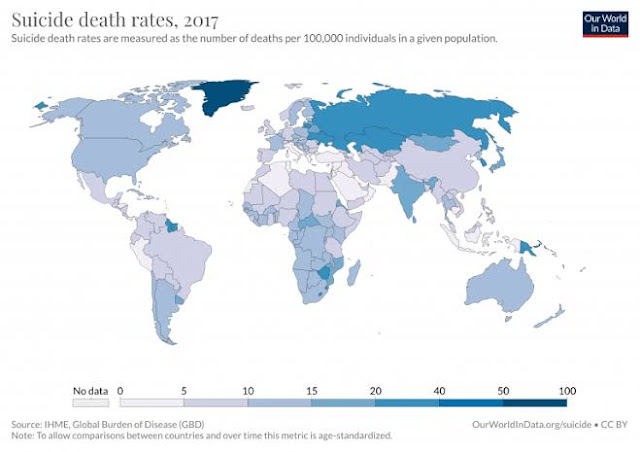Durkheim's study of suicide rates
The research problem
The research problem
One of the most unsettling aspects of our lives is the phenomenon of suicide, which often leaves those left behind with more questions than answers. Why do some people decide to take their own lives? Where do the pressures they experience actually come from? One of the early sociological classics which explores the relationship between the individual and society is Emile Durkheim's analysis of suicide rates, Suicide: A Study in Sociology ((Durkheim 1952 [1897]). Even though people see themselves as individuals exercising free will and choice, their behaviours are often socially patterned and shaped and Durkheim's study showed that even a highly personal act like suicide is influenced by what happens in the social world.
Research had been conducted on suicide prior to Durkheim's study, but he was the first to insist on a sociological explanation. Previous writers had acknowledged the influence of some social factors on suicide, but generally resorted to race, climate or mental disorder to explain an individual's likelihood of committing suicide. According to Durkheim, though, suicide was a social fact that could only be explained by other social facts. The suicide rate was more than simply the aggregate of individual suicides - it was a phenomenon with pattemed properties. Suicide rates, for example, vary widely across the world's societies.
In examining official suicide statistics in France, Durkheim found that certain categories of people were more likely to commit suicide than others. He discovered, for example, that there were more suicides amongst men than amongst women, more Protestants than Catholics, more wealthy than poor, and more single people than married people. Durkheim also noted that suicide rates tended to be lower during times of war and higher during times of economic change or instability. Why should this be so?
Durkheim's explanation
These findings led Durkheim to conclude that there are social forces external to the individual which affect suicide rates. He related his explanation to the idea of social solidarity and to two types of bonds within society-social integration and social regulation. Durkheim argued that people who were strongly integrated into social groups, and whose desires and aspirations were regulated by social norms, were less likely to commit suicide. He identified four types of suicide, in accordance with the relative presence or absence of integration and regulation.
1. Egoistic suicides are marked by low integration in society and occur when an individual is isolated, or when his or her ties to a group are weakened or broken. For example, the low rates of suicide amongst Catholics could be explained by their strong social community, while the personal and moral freedom of Protestants mean that they stand alone' before God. Marriage protects against suicide by integrating the individual into a stable social relationship, while single people remain more isolated within society. The lower suicide rate during wartime, according to Durkheim, can be seen as a sign of heightened social integration in the face cf an extermal enemy.
2. Anomic suicide is caused by a lack of social regulation. By this, Durkheim was referring to the social conditions of anomie when people are rendered 'normless' as a result of rapid change or instability in society. The loss of a fixed point of reference for norms and desires such as in times of economic upheaval or in personal struggles like divorce - can upset the balance between people's circumstances and their desires.
3. Altruistic suicide occurs when an individual is. over-integrated'-social bonds are too strong and values society more than him- or herself. In such a case, suicide becomes a sacrifice for the 'greater good'. Japanese kamikaze pilots or Islamic 'suicide bombers' are examples of altruistic suicides. Durkheim saw these as characteristic of traditional Societies where mechanical solidarity prevails.
4. The final type of suicide is fatalistic suicide. Although Durkheim saw this as of little contem- porary relevance, he believed that it results when an individual is over regulated by society. The oppression of the individual results in a feeling of powerlessness before fate or society.
Suicide rates vary between societies but show regular patterms within societies over time. Durkheim took this as evidence that there are consistent social forces that influence suicide rates. An examination of suicide rates reveals how general social patterns can be detected within individual actions.
Critical points
Since the publication of Suicide, many objections have been raised to Durkheim's study, particularly in relation to his uncritical use of official statistics, his dismissal of non- Social influences on suicide and his insistence in classifying all types of suicide together. Some critics have also shown that it is vitally important to understand the social process involved in collecting data on suicides, as coroners' definitions and criteria influence the number of deaths actually recorded as suicides'. Because of this, suicide statistics may be highly variable across societies, not necessarily hecause of differences in suicidal behaviour but because of different practices used by coroners in recording unexplained deaths.
Contemporary significance
Nonetheless, despite such legitimate criticisms, Durkheim's study remains a classic. It helped to establish sociology as a discipline with its own subject - the study of social facts - and his fundamental argument in his book on suicide retains its force: that to grasp fully even the apparently most personal act of suicide demands a sociological explanation rather than simply one rooted in the exploration of personal motivation.

Comments
Post a Comment
If you have any doubts, please let me know